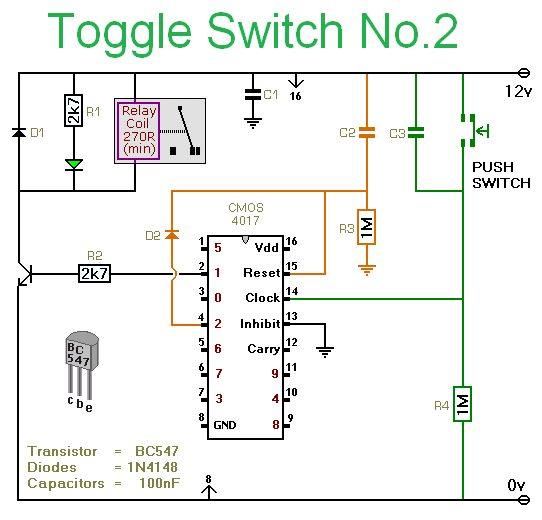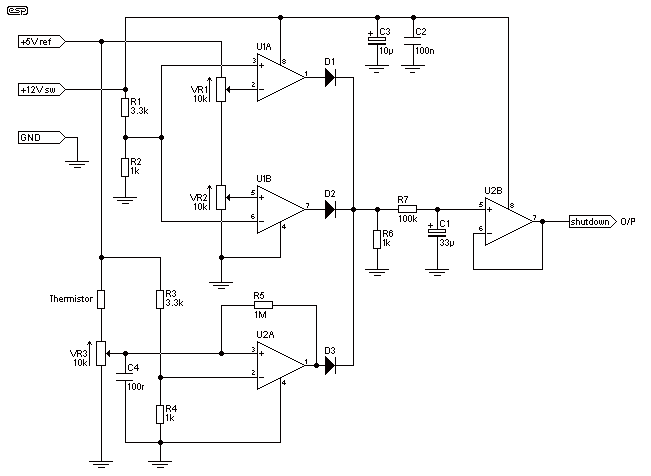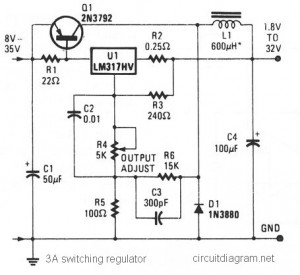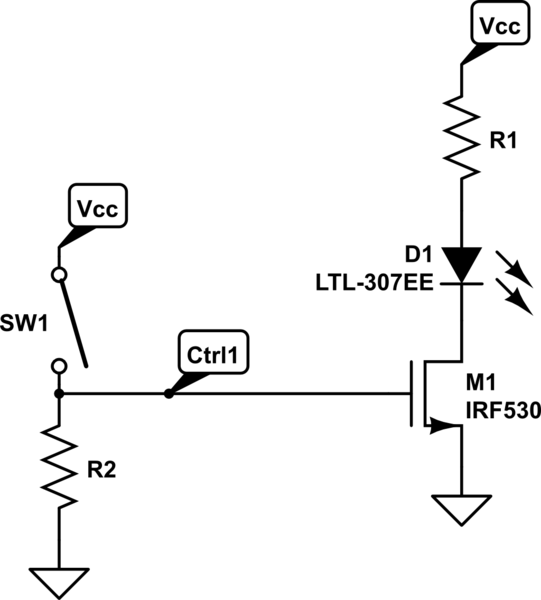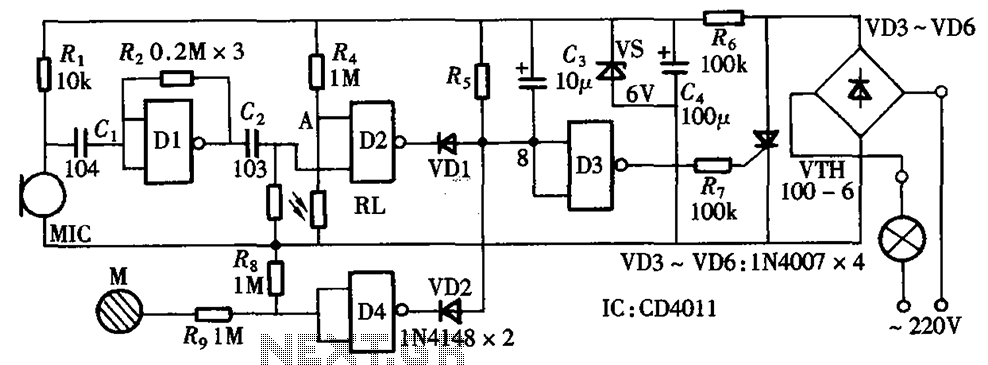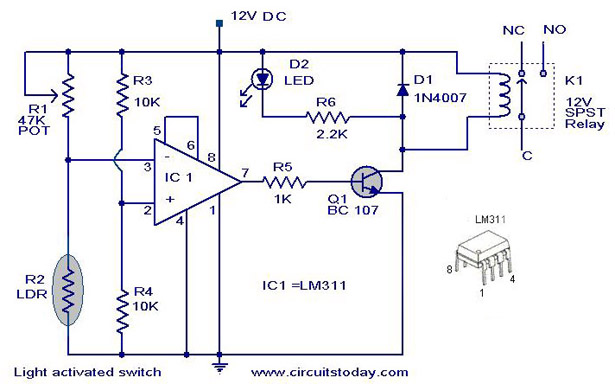
AC triggered switch
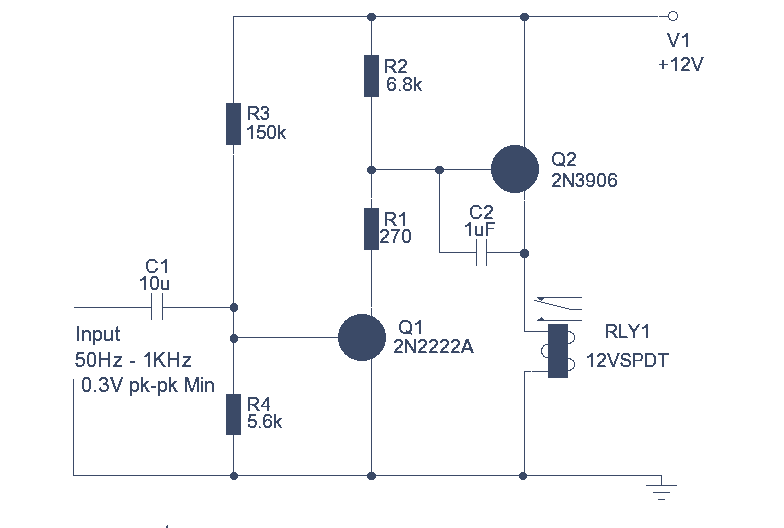
An AC triggered switch for low frequency signals. This is a basic ac voltage operated switch made from discrete components. Both Q1 and Q2 work as common emitter amplifiers, but the biasing of Q1 is arranged by R3 and R4 so that about 0.5V is applied to its base; so with no input signal both transistors and the load is off. More: With an input signal greater than 0.3V pk-pk (100mV RMS) the positive half of the waveform will switch on Q1, and Q2 and the relay. As the input signal switches to its negative transition, Q1 will switch off, but base current in Q2 continues to flow via C.
The described circuit functions as an AC-triggered switch designed for low-frequency signal applications. It employs two transistors, Q1 and Q2, configured as common emitter amplifiers, which are pivotal in controlling the flow of current to the load, represented by a relay.
Transistor Q1 is biased through resistors R3 and R4, establishing a base voltage of approximately 0.5V. This biasing is crucial as it ensures that in the absence of an input signal, both transistors remain in the off state, thus preventing any current flow through the load. The circuit is designed to respond to input signals above a threshold of 0.3V peak-to-peak (equivalent to 100mV RMS).
When an input signal exceeds this threshold, the positive half-cycle of the AC waveform activates Q1, allowing current to flow through Q2, which subsequently energizes the relay. This action effectively closes the circuit, enabling power to the load. As the input signal transitions into its negative half-cycle, Q1 turns off, but Q2 continues to conduct due to the base current flowing through capacitor C. This behavior ensures that the relay remains activated for the duration of the positive half-cycle, providing a stable output despite the AC signal's fluctuations.
The overall design is characterized by its simplicity and reliance on discrete components, making it a cost-effective solution for applications requiring reliable switching mechanisms in response to low-frequency AC signals. The careful selection of component values, particularly the biasing resistors and the capacitor, is essential for optimizing the circuit's performance and responsiveness to input signals.An AC triggered switch for low frequency signals. This is a basic ac voltage operated switch made from discrete components. Both Q1 and Q2 work as common emitter amplifiers, but the biasing of Q1 is arranged by R3 and R4 so that about 0.5V is applied to its base; so with no input signal both transistors and the load is off. With an input signal greater than 0.3V pk-pk (100mV RMS) the positive half of the waveform will switch on Q1, and Q2 and the relay. As the input signal switches to its negative transition, Q1 will switch off, but base current in Q2 continues to flow via C
🔗 External reference
The described circuit functions as an AC-triggered switch designed for low-frequency signal applications. It employs two transistors, Q1 and Q2, configured as common emitter amplifiers, which are pivotal in controlling the flow of current to the load, represented by a relay.
Transistor Q1 is biased through resistors R3 and R4, establishing a base voltage of approximately 0.5V. This biasing is crucial as it ensures that in the absence of an input signal, both transistors remain in the off state, thus preventing any current flow through the load. The circuit is designed to respond to input signals above a threshold of 0.3V peak-to-peak (equivalent to 100mV RMS).
When an input signal exceeds this threshold, the positive half-cycle of the AC waveform activates Q1, allowing current to flow through Q2, which subsequently energizes the relay. This action effectively closes the circuit, enabling power to the load. As the input signal transitions into its negative half-cycle, Q1 turns off, but Q2 continues to conduct due to the base current flowing through capacitor C. This behavior ensures that the relay remains activated for the duration of the positive half-cycle, providing a stable output despite the AC signal's fluctuations.
The overall design is characterized by its simplicity and reliance on discrete components, making it a cost-effective solution for applications requiring reliable switching mechanisms in response to low-frequency AC signals. The careful selection of component values, particularly the biasing resistors and the capacitor, is essential for optimizing the circuit's performance and responsiveness to input signals.An AC triggered switch for low frequency signals. This is a basic ac voltage operated switch made from discrete components. Both Q1 and Q2 work as common emitter amplifiers, but the biasing of Q1 is arranged by R3 and R4 so that about 0.5V is applied to its base; so with no input signal both transistors and the load is off. With an input signal greater than 0.3V pk-pk (100mV RMS) the positive half of the waveform will switch on Q1, and Q2 and the relay. As the input signal switches to its negative transition, Q1 will switch off, but base current in Q2 continues to flow via C
🔗 External reference
